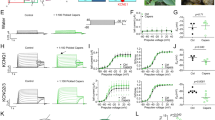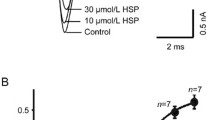Abstract
Flavonoids are naturally occurring food ingredients that have been associated with reduced cardiovascular mortality in epidemiological studies. In a previous study, we demonstrated for the first time that flavonoids are inhibitors of cardiac human ether-à-go-go-related gene (HERG) channels. Furthermore, we observed that grapefruit juice induced mild QTc prolongation in healthy subjects. HERG blockade by grapefruit flavonoid naringenin is most likely to be the mechanism underlying this effect. Therefore, the electrophysiological properties of HERG blockade by naringenin were analysed in detail. HERG potassium currents expressed in Xenopus oocytes were measured with a two-microelectrode voltage clamp. Naringenin blocked HERG potassium channels with an IC50 value of 102.6 μM in Xenopus oocytes. The onset of blockade was fast. The effect was completely reversible upon wash-out. Naringenin binding to HERG required aromatic residue F656 in the putative pore binding site. Channels were blocked in the open and inactivated states but not in the closed states. Naringenin did not affect HERG current activation. However, the half maximal inactivation voltage was shifted by 14.9 mV towards more negative potentials and current inactivation at negative potentials was accelerated. No frequency dependence of blockade was observed. Naringenin inhibits HERG channels with pharmacological characteristics similar to those of well-known HERG antagonists. From a clinical point of view, this effect could have both proarrhythmic and antiarrhythmic consequences. This may have important implications for phytotherapy and for dietary recommendations for cardiologic patients. Therefore, electrophysiological effects of flavonoids deserve further investigation.









Similar content being viewed by others
References
Ameer B, Weintraub RA, Johnson JV, Yost RA, Rouseff RL (1996) Flavanone absorption after naringin, hesperidin, and citrus administration. Clin Pharmacol Ther 60:34–40
Curran ME, Splawski I, Timothy KW, Vincent GM, Green ED, Keating MT (1995) A molecular basis for cardiac arrhythmia: HERG mutations cause long QT-syndrome. Cell 80:795–803
De Lorgeril M (1998) Mediterranean diet in the prevention of coronary heart disease. Nutrition 14:55–57
Erlund I, Meririnne E, Alfthan G, Aro A (2001) Plasma kinetics and urinary excretion of the flavanones naringenin and hesperetin in humans after ingestion of orange juice and grapefruit juice. J Nutr 131:235–241
Fernandez D, Ghanta A, Kauffman G, Sanguinetti M (2004) Physical chemical features of the HERG channel drug binding site. J Biol Chem 279:10120–10127
Geleijnse JM, Launer LJ, Van der Kuip DAM, Hofmann A, Wittemann JCM (2002) Inverse association of tea and flavonoid intakes with incident myocardial infarction: the Rotterdam study. Am J Clin Nutr 75:880–886
Hertog MG, Feskens EJ, Hollman PC, Katan MB, Kromhout D (1993) Dietary antioxidant flavonoids and risk of coronary heart disease: the Zutphen elderly study. Lancet 342:1007–1011
Ho P, Saville DJ (2001) Inhibition of human CYP3A4 activity by grapefruit flavonoids, furanocoumarins and related compounds. J Pharm Pharmaceut Sci 4:217–227
Huikuri HV, Castellanos A, Myerburg RJ (1999) Sudden death due to cardiac arrhythmias. N Engl J Med 345:1473–1482
Jurkiewicz NK, Sanguinetti MC (1993) Rate-dependent prolongation of cardiac action potentials by a methanesulfonanilide class III antiarrhythmic agent. Specific block of rapidly activating delayed rectifier K+ current by dofetilide. Circ Res 72:75–83
Karle C, Thomas D, Kiehn J (2002) The antiarrhythmic drug BRL-32872. Cardiovasc Drug Rev 20:111–120
Kiesecker C, Zitron E, Lück S, Bloehs R, Scholz EP, Kathöfer S, Thomas D, Kreye VA, Katus HA, Schoels W, Karle CA, Kiehn J (2004) Class Ia antiarrhythmic drug ajmaline blocks HERG potassium channels: mode of action. Naunyn-Schmiedebergs Arch Pharmacol 417:221–228
Knekt P, Jarvinen R, Reunanen A, Maatela J (1996) Flavonoid intake and coronary mortality in Finland: a cohort study. Brit Med J 312:478–481
Madeja M, Musshoff U, Speckmann EJ (1997) Follicular tissues reduce drug effects on ion channels in oocytes of Xenopus laevis. Eur J Neurosci 9:599–604
Middleton E Jr, Kandaswami C, Theoharides TC (2000) The effects of plant flavonoids on mammalian cells: implications for inflammation, heart disease, and cancer. Pharmacol Rev 52:673–751
Mitcheson JS, Chen J, Lin M, Culberson C, Sanguinetti MC (2000) A structural basis for drug-induced long QT syndrome. Proc Natl Acad Sci U S A 97:12329–12333
Mukamal KJ, Maclure M, Muller JE, Sherwood JB, Mittleman MA (2002) Tea consumption and mortality after acute myocardial infarction. Circulation 105:2476–2481
Numaguchi H, Mullins FM, Johnson JP, Johns DC, Po SS, Yang IC, Tomaselli GF, Balser JR (2000) Probing the interaction between inactivation gating and d-sotalol block of HERG. Circ Res 87:1012–1018
Pearlstein RA, Vaz RJ, Kang J, Chen XL, Preobrazhenskaya M, Shchekotikhin AE, Korolev AM, Lysenkova LN, Miroshnikova OV, Hendrix J, Rampe D (2003) Characterization of HERG potassium channel inhibition using CoMSiA 3D QSAR and homology modelling approaches. Bioorg Med Chem Lett 13:1829–1835
Pratt CM (2003) Pure class III agents for prevention of sudden cardiac death. J Cardiovasc Electrophysiol 14 [Suppl]:S82–S86
Priori SG, Napolitano C (2002) Genetic defects of cardiac ion channels. The hidden substrate for torsade de pointes. Cardiovasc Drugs Ther 16:89–92
Redfern WS, Carlsson L, Davis AS, Lynch WG, MacKenzie I, Palethorpe S, Siegl PK, Strang I, Sullivan AT, Wallis R, Camm AJ, Hammond TG (2003) Relationships between preclinical cardiac electrophysiology, clinical QT interval prolongation and torsade de pointes for a broad range of drugs: evidence for a provisional safety margin in drug development. Cardiovasc Res 58:32–45
Renaud S, de Lorgeril M (1992) Wine, alcohol, platelets, and the French paradox for coronary heart disease. Lancet 339:1523–1526
Rimm EB, Katan MB, Ascheiro A, Stampfer MJ, Willet WC (1996) Relation between intake of flavonoids and risk for coronary heart disease in male health professionals. Ann Intern Med 125:384–389
Scholz EP, Zitron E, Kiesecker C, Lueck S, Kathöfer S, Thomas D, Weretka S, Peth S, Kreye VA, Schoels W, Katus HA, Kiehn J, Karle CA (2003) Drug binding to aromatic residues in the HERG channel pore cavity as possible explanation for acquired long QT syndrome by antiparkinsonian drug budipine. Naunyn-Schmiedebergs Arch Pharmacol 368:404–414
Singh BN, Nademanee K (1985) Control of cardiac arrhythmias by selective lengthening of repolarisation: theoretic considerations and clinical observations. Am Heart J 109:421–430
Spector PS, Curran ME, Keating MT, Sanguinetti MC (1996) Class III antiarrhythmic drugs block HERG, a human cardiac delayed rectifier K+ channel. Circ Res 78:499–503
Waldo AL, Camm AJ, de Ruyter H, Friedman PL, MacNeil DJ, Pauls JF, Pitt B, Pratt CM, Schwartz PJ, Veltri EP (1996) Effect of D-Sotalol on mortality in patients with left ventricular dysfunction after recent and remote myocardial infarction. The SWORD investigators. Survival with Oral D-Sotalol. Lancet 348:7–12
Walker BD, Singleton CB, Tie H, Bursill JA, Wyse KR, Valenzuela SM, Breit SN, Campbell TJ (2000) Comparative effects of azimilide and ambasilide on the human-ether-a-gogo-related gene (HERG) potassium channel. Cardiovasc Res 48:44–58
Witchel HJ, Milnes JT, Mitcheson JS, Hancox JC (2002) Troubleshooting problems with in vitro screening of drugs for QT interval prolongation using HERG K+ channels expressed in mammalian cell lines and Xenopus oocytes. J Pharmacol Toxicol Methods 48:65–80
Yochum L, Kushi LH, Meyer K, Folsom AR (1999) Dietary flavonoid intake and risk of cardiovascular disease in postmenopausal women. Am J Epidemiol 149:943–949
Zitron E, Karle CA, Wendt-Nordahl G, Kathofer S, Zhang W, Thomas D, Weretka S, Kiehn J (2002) Bertosamil blocks HERG potassium channels in their open and inactivated states. Br J Pharmacol 137:221–228
Zitron E, Scholz EP, Owen R, Lück S, Kiesecker C, Thomas D, Kathöfer S, Niroomand F, Kiehn J, Kreye VA, Katus HA, Schoels W, Karle CA (2005) QTc prolongation by grapefruit juice and its potential pharmacologic basis: HERG channel blockade by flavonoids. Circulation 111:835–838
Acknowledgements
This paper was awarded the Rudolph-Fritz-Weiss-Prize 2004 by the German Society of Phytotherapy. The excellent assistance of Klara Gueth and Ramona Bloehs is gratefully acknowledged. This work was supported by grants from the Deutsche Forschungsgemeinschaft Ki 663/1-1 to Dr. Kiehn, KA 1714/1-1 to Dr. Karle, and TH 1120/1-1 to Dr. Thomas, from the Deutsche Stiftung für Herzforschung (project F/10/03) to Dr. Thomas, from the German Cardiac Society (Max Schaldach Research Scholarship) to Dr. Thomas and from the Karl and Veronica Carstens-Stiftung to E. Scholz.
Author information
Authors and Affiliations
Corresponding author
Additional information
E. Scholz and E. Zitron contributed equally to this work
Rights and permissions
About this article
Cite this article
Scholz, E.P., Zitron, E., Kiesecker, C. et al. Inhibition of cardiac HERG channels by grapefruit flavonoid naringenin: implications for the influence of dietary compounds on cardiac repolarisation. Naunyn Schmied Arch Pharmacol 371, 516–525 (2005). https://doi.org/10.1007/s00210-005-1069-z
Received:
Accepted:
Published:
Issue Date:
DOI: https://doi.org/10.1007/s00210-005-1069-z




